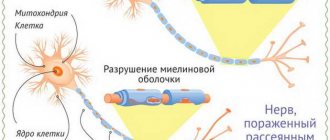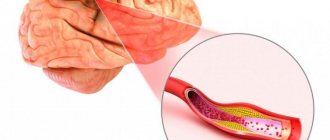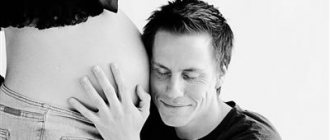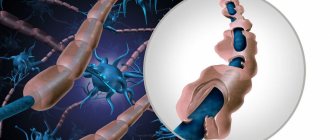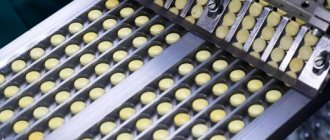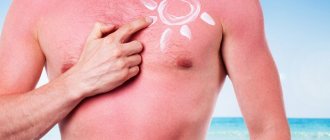Diagnostics
To determine multiple sclerosis, doctors use interviews and neurological examinations, and then confirm the diagnosis with MRI studies and tests.
MRI scans the brain and spinal cord for old and new lesions. For better visualization of fresh plaques, contrast is used. The diagnosis is made if the patient has 4 or more foci of demyelination measuring at least 3 mm, or 3 foci near the lateral ventricles, in the brain stem, cerebellum or spinal cord. In addition to MRI, the following may be prescribed for multiple sclerosis:
- regular blood tests to determine the level of immunoglobulins in the cerebrospinal fluid;
- lumbar punctures to study the composition of the spinal cord fluid.
How to stop multiple sclerosis: treatment of different forms of the disease
Unfortunately, despite progress in MS therapy, it is not yet possible to completely defeat the disease. However, if a person has multiple sclerosis, treatment can help reduce symptoms and reduce the number of relapses. Therapy is prescribed depending on the severity of the disease.
For progressive forms of MS, treatment can help reduce the severity of the disease. Specialists can prescribe:
- plasmapheresis - purification of the patient's blood;
- immunosuppressants - drugs that artificially suppress the immune system;
- immunomodulators are medications that regulate the body's immune response.
To prevent relapses, B-interferons can be used, and to reduce the intensity of symptoms, the following are used:
- vitamins E and B complexes;
- nootropics that improve brain activity;
- anticholinesterase drugs that inhibit the activity of the nervous system;
- muscle relaxants that help reduce muscle tone;
- enterosorbents that help remove toxins.
ethnoscience
As often happens, when traditional methods are powerless, people use traditional methods to treat multiple sclerosis.
But it should be remembered that when using traditional methods, one should not forget about the medications prescribed by the doctor.
Combined treatment can achieve positive changes in the fight against the disease. The patient's condition stabilizes, in some cases significant improvements are noticeable.
The main advantage of traditional methods of treatment is that all herbal preparations, decoctions and other remedies consist of natural ingredients.
This allows them to be used for treatment by everyone without exception, without fear of allergic reactions and other side effects.
Rehabilitation for multiple sclerosis
- Physiotherapy.
Exercise therapy helps improve a person’s condition with impaired motor activity. Working out on exercise machines helps restore coordination of movements. With correctly selected loads, the method demonstrated excellent efficiency. - Physiotherapy.
For patients with MS, electrophoresis, myostimulation, ultrasound, and magnetic therapy are recommended. These techniques help to activate the body's metabolic processes and reduce inflammation. - Massage.
For multiple sclerosis, this rehabilitation method can be used to relieve pain symptoms and spasms. Massage also helps improve muscle tone when it decreases.
Rehabilitation for multiple sclerosis also includes psychotherapy, which will help the patient cope with negative thoughts, as well as consultations with a nutritionist.
Disease prognosis
Multiple sclerosis is not considered a fatal disease; the unpleasant symptoms of MS can be quite successfully treated. Scientists have found that thanks to modern treatment, the life expectancy of patients today has increased significantly compared to those who fell ill even a few decades ago.
Overall, people with multiple sclerosis live on average 7 years less than the general population. Often, a decrease in life expectancy is associated with complications of other pathologies: cancer and cardiovascular diseases. For many patients, quality treatment can prevent a decline in quality of life and productivity. According to the National Multiple Sclerosis Society, ⅔ of people with MS are wheelchair-free even 20 years after diagnosis.
Disability in multiple sclerosis
| If multiple sclerosis has caused disability for 5 months or more within a year, the patient can apply for disability registration. |
After reviewing the documents, the commission will make a decision on incapacity for work, which gives the right to receive a pension and preferential working conditions. The establishment of a disability group is influenced by:
- the period for which the ability to work was lost;
- the period when the patient was registered with this disease;
- frequency, duration and severity of exacerbations;
- therapy results;
- changes in the course of the disease, the rate of development of symptoms.
Disability is assigned for a year, after which it is necessary to pass the commission again. Disability of groups I and II with MS gives the right to a reduced working day - 35 hours per week. In this case, wages are paid in full.
Traditional medicine recipes
Various herbal decoctions and tinctures help well with multiple sclerosis.
Here are some recipes for folk remedies for multiple sclerosis:
- Chop two tablespoons of rose hips and mix with the same amount of onion peels and spruce needles. Then add 0.7 liters of water to the mixture and simmer over low heat for 10 minutes. The resulting broth is left to stand for approximately 8 hours. Take throughout the day.
- One teaspoon each of lemon balm, valerian, hops, marshmallow root and peppermint is mixed with two dessert spoons of oregano. Brew as tea with 500 g of boiling water and leave for 1 hour. It is recommended to drink 3 times a day before meals.
- Add a tablespoon of Echinops seeds to 250g of vodka and let it sit for 3 weeks in a cool place. During the settling process, the tincture must be shaken twice a day. Take only diluted 30 ml of tincture in 50 ml of water, 15 minutes before meals. Before going to bed, 1 spoon of tincture can be rubbed into the spine area.
- You can make a herbal collection. To do this, you need to mix in equal proportions: yarrow herb, chamomile flowers, calamus and licorice roots, birch buds, calendula, tricolor violet, chicory, St. John's wort, immortelle, dandelion root and elecampane root. Grind the collection thoroughly and brew two tablespoons per two cups of boiling water. The resulting collection should sit overnight. Take it half a glass 3 times a day.
- 1 kg of chokeberry, mixed with 1 kg of sugar. It is recommended to take 1 teaspoon 3 times a day. 1 teaspoon of buckwheat is poured into 500 ml of boiling water and left for 3 hours. Then filter and drink half a glass 3 times a day.
- A glass of chopped garlic mixed with two glasses of honey. Take 1 teaspoon 3-5 times a day.
- Grind the elecampane root and add alcohol at the rate of 30 g of plant per 500 g. Keep the tincture in a dark, cool place for a month. Take a teaspoon in the morning and evening. After a week of treatment, the dose is increased to 1 tablespoon 3 times a day.
Prevention of cerebral atherosclerosis
- Eliminate risk factors. Some of them - unmodifiable ones - cannot be removed. However, quitting smoking and drinking, doing simple exercises and watching your diet are quite accessible means of prevention.
- Exercise stress. Useful for weight control and improving the functioning of the cardiovascular system. Important: before you start playing sports, you need to undergo an examination. Doctors will conduct stress tests and select an acceptable activity regimen. Otherwise, you can harm yourself and make your health worse. In everyday life, it is recommended to walk more, climb stairs instead of riding the elevator, and work in the garden. You need to walk for 30 minutes at least 3-4 times a week.
- Regular examinations with a doctor. At the Yusupov Hospital you can undergo a preventive examination. During the consultation, a specialist will help identify risk factors and eliminate them.
- Weight control. BMI should be between 18.5-24.9 (see above). At each visit to the doctor, you are weighed and your waist circumference is measured.
- Blood pressure control. The close connection of atherosclerosis with high blood pressure forces patients to monitor their blood pressure.
- Control of laboratory parameters: LDL, HDL, total cholesterol, triglycerides, transaminases, blood sugar.
Preventing problems during pregnancy
You need to start thinking about your child’s health even before conception. The expectant mother should give up bad habits if she has them and carefully monitor her health. Complicated pregnancy or difficult childbirth are often the cause of the development of the syndrome. After childbirth, you need to protect your baby from infectious diseases, possible injuries and other negative influences.
Even infants need developmental activities. You can show your baby bright objects and talk about their purpose. Of course, the baby will not understand what is said, but he will concentrate on the bright colors and familiar voice. A little later, age-appropriate educational toys should be used.
Many parents struggle with attention disorder. This problem is especially relevant for younger schoolchildren. Without qualified help, a child will not be able to concentrate on a particular activity for a long time, and will begin to experience problems in communication and learning. Therefore, it is very important to help him in a timely manner. You should start with a visit to a child psychologist.
Diagnosis of cerebral atherosclerosis
It is impossible to diagnose cerebral atherosclerosis based on complaints alone. The examination includes mandatory and additional studies.
Mandatory studies:
- Blood biochemistry: total cholesterol, LDL, HDL, triglycerides;
- General blood analysis;
- Blood sugar;
- Coagulogram;
- Atherogenic coefficient;
- ECG;
- Dopplerography of extracranial arteries.
Additional research:
- Blood biochemistry: liver transaminases (ALT, AST), creatinine, CPK;
- Coagulogram for D-dimer;
- Enzyme-linked immunosorbent assay (ELISA): determination of antinuclear factor;
- Protein fractions;
- C-reactive protein;
- Duplex scanning of head and neck vessels;
- Color Doppler mapping (ultrasound option);
- EchoCG;
- MRI, CT with contrast;
- PAT;
- SCT angiography of brachiocephalic arteries;
- Examination of the fundus to detect changes in the retinal vessels.
A set of necessary studies is available at the Yusupov Hospital.
Cases when consultations with specialized specialists are required:
- Suspicion of acute coronary syndrome - cardiologist.
- Stenosing lesions of neck vessels - angiosurgeon.
- Lesions of intracranial arteries - neurosurgeon.
- Problems with blood clotting - hematologist.
- High blood sugar - endocrinologist.
- Severe mental disorders - psychiatrist.
Mild to moderate narrowing
With mild or moderate narrowing of the arteries, it is enough to adhere to the following recommendations to prevent the development of a stroke:
- Lifestyle changes. Maintaining a healthy lifestyle will help reduce arterial stress and slow the progression of atherosclerosis. Prevention and treatment of carotid artery stenosis include smoking cessation, weight loss, a healthy diet, limiting salt intake, and regular exercise.
- Treatment of chronic diseases. Treat any chronic diseases you have, such as hypertension, obesity or diabetes. Make a treatment plan for these conditions with your doctor by monitoring your blood pressure, maintaining a healthy weight, and controlling your blood sugar and cholesterol.
- Taking medications. If the blood vessels in the neck are moderately narrowed, your doctor will recommend taking aspirin or another blood thinner daily to prevent the formation of dangerous blood clots. Medicines to lower blood pressure, such as angiotensin-converting enzyme (ACE) inhibitors or calcium channel blockers, or statins to lower blood cholesterol are also prescribed.
Features of the diagnosis of SRV
Distracted attention syndrome is a behavioral disorder, not a mental disorder, so establishing an accurate diagnosis can be problematic. Individual manifestations may arise due to improper upbringing or personal characteristics.
It is necessary to resort to subjective diagnostic methods, among them are:
- Special questionnaires. They must be filled out not only by the student, but also by parents and teachers.
- Observation. It is necessary to monitor behavior while staying somewhere and at home.
- Psychological examination. It is important to identify intellectual abilities and skill impairments.
- Identification of diseases. Perhaps early illnesses of the child or his mother could have caused the appearance of this disease.
You need to make sure that your child has absent-mindedness syndrome, because restlessness and activity are also common in many healthy children. There is no doubt about the presence of the disease in the following cases:
- Constant symptoms of the disorder not only at home, but also at school, while out and about.
- Parents discovered the first signs in preschool age, and they did not go away for six months.
- Attention disorder interferes with a child’s learning; he cannot adapt normally to a team.



